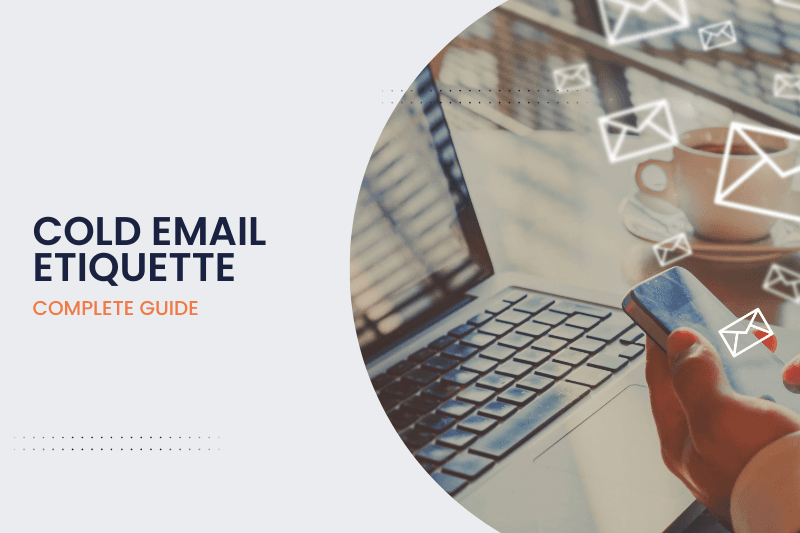Cold Email
Cold Email Etiquette Guide: Essential Rules for Success
This guide covers the fundamentals of crafting effective cold emails that resonate with recipients, ensuring compliance with legal standards, and employing tactics for higher engagement. Learn to personalize your approach, measure success, and build lasting connections through thoughtful cold emailing.
Dec 11, 2023

You've crafted the perfect cold email, but will it hit the mark or vanish into the abyss of the recipient's spam folder? Understanding the rules of cold emailing is crucial for your message to not only be seen but also to resonate with potential clients or collaborators.
In this ultimate guide, you'll unlock the secrets to successful cold emailing. You'll learn the dos and don'ts, how to stay compliant with laws, and the strategies that'll have your emails eagerly anticipated, not promptly deleted.
Stick around to transform your cold email approach into a game-changing tool for your business outreach.
What is Cold Emailing?
Defining Cold Emailing
Imagine reaching out to a potential lead or a future collaborator without prior interaction – that's cold emailing. It’s akin to a digital handshake, an introduction where you’re unseen but hoping to become unforgettable.
In essence, it’s sending an email to recipients who don’t necessarily know you or your business, seeking to establish a connection, promote a product, or propose a partnership.
When crafting a cold email, the aim is to tailor a message that resonates, subtly nudging the recipient toward a specific action, such as scheduling a call or checking out your service.
As opposed to spam, cold emails are targeted, with each sent based on thorough research and strategic planning. This method of outreach is a core lesson in the ultimate cold email guide.
Benefits of Cold Emailing
Learning and mastering cold emailing can catapult your networking capabilities to new heights.
The advantages of incorporating cold emails into your marketing and outreach strategies are numerous:
Personalization at Scale: Cold emailing allows for a high degree of personalization, something crucial in today’s market where personalized approaches are highly valued.
Cost-Effectiveness: With no need for an extensive budget, cold emails offer an affordable way to reach prospects compared to many advertising methods.
Increased ROI: A well-timed and well-crafted cold email can pull in a significant return on investment, making it a favorite among growth hackers and marketers.
Direct Contact: It establishes a direct line of communication, providing an opportunity to cut through the noise and speak directly to decision-makers.
As you learn about cold emailing, remember that these benefits only manifest when the rules are respected and strategies are thoughtfully applied.
Your ability to become a cold email master hinges on not just understanding the power of a well-turned phrase, but also navigating the subtleties of etiquette and compliance.
By harnessing the potential of cold emails, you’re not just opening a dialogue with prospective clients or collaborators, you're potentially setting the stage for lasting business relationships.
It’s about more than just reaching inboxes; it's about crafting a narrative that compels and converts.
The Dos of Cold Emailing
1. Research Your Recipients
Before crafting your ultimate cold email, it's essential that you thoroughly research your recipients. Understanding who you're reaching out to can make a monumental difference. Start by analyzing their business, role, and potential pain points. This insight is your golden ticket to framing an email that resonates. Here's how to become a cold email master in research:
Leverage social media platforms like LinkedIn to gather information on their professional background.
Scan company news and press releases for recent achievements or shifts in strategy.
Identify common connections that might provide additional context or a warm introduction.
This preparatory step is the bedrock of effective cold emailing. You’ll learn cold emailing faster by routinely practicing meticulous research.
2. Personalize Your Message
The key to standing out in a crowded inbox is crafting a message that speaks directly to your recipient. Personalization is not just about using their name; it's about letting them know why you're specifically reaching out to them. Employ the following tactics:
Reference a recent success or milestone they’ve had to show you're paying attention.
Tie your proposition to how it aligns with their goals or challenges.
Use a tone that matches their communication style, deduced from their social media or published work.
3. Keep It Short and Concise
Your busy recipients will thank you for getting straight to the point. The ultimate guide to cold email highlights brevity as a non-negotiable. Here’s how you can keep it short yet impactful:
Create a sharp, compelling subject line that piques interest.
Start with a brief introduction, immediately followed by the value proposition.
Use bullet points to outline key benefits or next steps.
Aim for a length that fits on a single screen without scrolling.
By following these do's of cold emailing, you’re laying the foundation for emails that not only get opened but also acted upon. As you continue to refine your approach, you'll see greater engagement, and with time, you may just become a cold email master.
The Don'ts of Cold Emailing
1. Sending Unsolicited Emails
When you’re diving into the ultimate cold email guide, it’s vital to understand that consent is paramount. Sending unsolicited emails to individuals who haven’t expressed interest in your services can quickly tarnish your reputation and hurt your brand. To become a cold email master, you must acquire permission before adding anyone to your email list.
Otherwise, you could be violating anti-spam laws, leading to hefty fines and damaged relationships. Always ensure your efforts align with best practices in how to cold email, predominantly focused on respect and legality.
2. Using Generic Templates
Crafting cold emails mandates a shift from the impersonal to the customized. Using generic templates undermines the personalized approach that's been recommended. When you learn about cold emailing, you’ll understand that recipients are quick to identify and ignore such impersonal outreach.
Therefore, discard the cookie-cutter approach and tailor each email to the individual. A personalized touch demonstrates that you’ve invested time in understanding the recipient's business and specific needs—an approach that paves the way for meaningful conversations and potential collaborations.
3. Being Too Pushy
Mastering the art of cold emailing means striking the right balance between assertiveness and respect. It's a common mistake to be too pushy in follow-up emails or calls. Remember, the goal of your initial cold email is to open a line of communication, not to force a sale or decision. Patience is your asset here.
Engaging with potential clients or partners should feel like a natural progression, not a high-pressure situation. Keep your follow-ups polite and spaced out, providing value each time. This assists in building a rapport that could eventually convert prospects into paying customers without the need for aggressive tactics.
Crafting a Cold Email Strategy
1. Identifying Your Target Audience
Before you draft your first message, zero in on who'll be on the receiving end. Knowing your audience is paramount to the success of your cold email campaign. To pinpoint your ideal prospect, consider these factors:
Industry-related needs: What challenges does your target face?
Job titles: Are you reaching out to decision-makers or influencers?
Company size: Do you offer scale to small startups or massive enterprises?
Probe into your contacts' digital footprints—LinkedIn profiles, published articles, or company press releases—to learn cold emailing techniques that resonate with them.
2. Creating a Compelling Subject Line
The subject line is your first, and sometimes only, shot at making an impression. To craft a subject that beckons a click, implement these tactics:
Spark curiosity: Pique interest without giving it all away.
Personalise: Use the recipient’s name or company to stand out.
Convey urgency or value: Imply that your email contains time-sensitive information or considerable benefits.
Experiment with A/B testing to refine your approach and become a cold email master.
3. Writing an Engaging Body
An irresistible email body can anchor your recipient’s attention and elicit a response. Ensure your message is:
Concise: Get to the point. Long-winded emails often go unread.
Relevant: Tie in how your solution addresses their unique needs or pain points.
Value-driven: Highlight how your proposition adds value to their business.
Additionally, integrate a clear call-to-action (CTA) that nudges your recipient towards the next steps. Whether it’s scheduling a call, visiting a webpage, or downloading a guide, your CTA should be definite and simple to follow.
By weaving together the right audience insights, a subject line that commands attention, and an engaging message body, you’ll lay a solid foundation for your cold email strategy.
As part of the ultimate cold email guide, each step you take in personalizing and tailoring your approach solidifies the pathway to securing those highly coveted responses and partnerships.
Continue to iterate and enhance your campaigns for the best outcomes in your cold emailing endeavors.
Tips for Building Relationships through Cold Emailing
1. Offering Value
When you embark on your journey with cold emailing, always lead with generosity. Offering Value is the cornerstone of any successful cold email strategy. Before you hit send, ask yourself, "What's in it for them?"
Remember to:
Share exclusive content or insights
Provide solutions to their pain points
Offer helpful tools or resources
This approach not only captures attention but also starts the relationship on a positive note. As you learn cold emailing, it's paramount to give your recipients a reason to engage.
2. Establishing Trust and Credibility
To become a cold email master, prioritizing trust is non-negotiable. Nurturing trust and credibility begins with your first interaction.
Make sure to:
Personalize your message to show genuine interest
Keep your promises and commitments
Display your expertise and authority in your field
By doing so, you lay a sturdy foundation for a trustworthy relationship. Remember, your ultimate cold email guide should include a vetted signature and company information to bolster credibility.
3. Follow-up with Care
The art of follow-up can make or break your cold email endeavors. It's crucial to strike a balance between persistence and respect for the recipient's time. Here's how:
Space out your follow-ups thoughtfully
Add new information or value to each contact
Acknowledge their busy schedule
By following up with care, you demonstrate your commitment without being overbearing. Effective follow-ups can often lead to positive outcomes, so don't overlook this critical step in your learn-cold emailing process.
Measuring Success and Making Improvements
Continuing with your journey on how to cold email, it's essential to identify key metrics that determine the effectiveness of your cold email campaigns. Measuring success and making necessary improvements will help you sharpen your skills and become a cold email master.
1. Tracking Open and Response Rates
Your open and response rates are critical indicators of how well your email resonates with recipients.
To master the ultimate cold email guide:
Use email tracking tools to monitor who opens your emails and when.
Analyze the data to identify trends, such as the best day of the week or time of day to send emails.
Keep a close eye on your response rates; they'll tell you if your call to action is compelling enough.
By tracking these rates, you'll gain invaluable insights into your recipients' behaviors, allowing you to refine your cold emailing strategy for better engagement.
2. Experimenting with Different Approaches
No two recipients are the same, which means experimenting with various approaches is vital. Here's how to cold email with variability:
A/B tests different subject lines to see which ones capture attention.
Vary your email content and structure to find the most effective format.
Personalization goes a long way; testing different degrees of personalized content can dramatically improve your success rate.
With each campaign, analyze what worked and what didn't; this continuous improvement cycle is the hallmark of an adept email marketer.
3. Learning from Mistakes
In your quest to learn cold emailing, you'll inevitably make mistakes. Yet, each misstep is an opportunity for growth.
Reflect on campaigns that didn't yield the desired results and ask yourself:
Were your emails targeted at the right audience?
Did your email provide value relevant to your recipient's needs?
How can your follow-up strategy be improved to remain persistent without being intrusive?
Taking time to dissect these questions and assessing your approach from your recipient's perspective will refine your technique, setting the stage for future successes in your cold email endeavors.
By closely examining the results of your efforts and not shying away from innovation or reflection, you'll effectively navigate through the complex landscape of cold emailing.
Use these insights to adapt and evolve, ensuring that each email you send out is an opportunity to connect, engage, and convert.
Frequently Asked Questions
1. How can I offer value to recipients through cold emailing?
Offer value to recipients through cold emailing by sharing exclusive content, providing solutions to their pain points, and offering helpful tools or resources.
2. How can I establish trust and credibility in cold emails?
Establish trust and credibility in cold emails by personalizing messages, keeping promises, and displaying expertise.
3. What is the art of follow-up in cold emailing?
The art of follow-up in cold emailing involves spacing out follow-ups, adding new information or value to each contact, and acknowledging the recipient's busy schedule.
4. How can I measure the success of cold email campaigns?
Measure the success of cold email campaigns by tracking open and response rates, experimenting with different approaches, and learning from mistakes.
5. How can I improve my cold emailing strategy?
Improve your cold emailing strategy by closely examining results, making adjustments based on data, and continuously refining your approach.
Conclusion
Mastering cold emailing is about building genuine connections and offering undeniable value. You've got the tools to personalize, follow up with finesse, and measure your impact. Remember, it's a game of patience and persistence.
By applying these insights, you'll enhance your approach, foster trust, and ultimately, drive results.
Embrace the continuous learning curve, and watch as your cold email campaigns transform into warm conversations with promising prospects. Keep refining, keep reaching out, and you're sure to see your efforts pay off.

